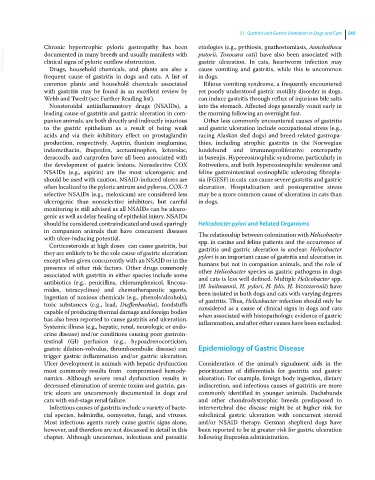Page 581 - Clinical Small Animal Internal Medicine
P. 581
51 Gastritis and Gastric Ulceration in Dogs and Cats 549
Chronic hypertrophic pyloric gastropathy has been etiologies (e.g., pythiosis, gnathostomiasis, Aonchotheca
VetBooks.ir documented in many breeds and usually manifests with putorii, Toxocara cati) have also been associated with
gastric ulceration. In cats, heartworm infection may
clinical signs of pyloric outflow obstruction.
Drugs, household chemicals, and plants are also a
frequent cause of gastritis in dogs and cats. A list of cause vomiting and gastritis, while this is uncommon
in dogs.
common plants and household chemicals associated Bilious vomiting syndrome, a frequently encountered
with gastritis may be found in an excellent review by yet poorly understood gastric motility disorder in dogs,
Webb and Twedt (see Further Reading list). can induce gastritis through reflux of injurious bile salts
Nonsteroidal antiinflammatory drugs (NSAIDs), a into the stomach. Affected dogs generally vomit early in
leading cause of gastritis and gastric ulceration in com- the morning following an overnight fast.
panion animals, are both directly and indirectly injurious Other less commonly encountered causes of gastritis
to the gastric epithelium as a result of being weak and gastric ulceration include occupational stress (e.g.,
acids and via their inhibitory effect on prostaglandin racing Alaskan sled dogs) and breed‐related gastropa-
production, respectively. Aspirin, flunixin meglumine, thies, including atrophic gastritis in the Norwegian
indomethacin, ibuprofen, acetaminophen, ketorolac, lundehund and immunoproliferative enteropathy
deracoxib, and carprofen have all been associated with in basenjis. Hypereosinophilic syndrome, particularly in
the development of gastric lesions. Nonselective COX Rottweilers, and both hypereosinophilic syndrome and
NSAIDs (e.g., aspirin) are the most ulcerogenic and feline gastrointestinal eosinophilic sclerosing fibropla-
should be used with caution. NSAID‐induced ulcers are sia (FGESF) in cats can cause severe gastritis and gastric
often localized to the pyloric antrum and pylorus. COX‐2 ulceration. Hospitalization and postoperative stress
selective NSAIDs (e.g., meloxicam) are considered less may be a more common cause of ulceration in cats than
ulcerogenic than nonselective inhibitors, but careful in dogs.
monitoring is still advised as all NSAIDs can be ulcero-
genic as well as delay healing of epithelial injury. NSAIDs
should be considered contraindicated and used sparingly Helicobacter pylori and Related Organisms
in companion animals that have concurrent diseases The relationship between colonization with Helicobacter
with ulcer‐ inducing potential. spp. in canine and feline patients and the occurrence of
Corticosteroids at high doses can cause gastritis, but
they are unlikely to be the sole cause of gastric ulceration gastritis and gastric ulceration is unclear. Helicobacter
pylori is an important cause of gastritis and ulceration in
except when given concurrently with an NSAID or in the humans but not in companion animals, and the role of
presence of other risk factors. Other drugs commonly other Helicobacter species as gastric pathogens in dogs
associated with gastritis in either species include some and cats is less well defined. Multiple Helicobacter spp.
antibiotics (e.g., penicillins, chloramphenicol, lincosa- (H. heilmannii, H. pylori, H. felis, H. bizzozeronii) have
mides, tetracyclines) and chemotherapeutic agents. been isolated in both dogs and cats with varying degrees
Ingestion of noxious chemicals (e.g., phenols/alcohols), of gastritis. Thus, Helicobacter infection should only be
toxic substances (e.g., lead, Dieffenbachia), foodstuffs considered as a cause of clinical signs in dogs and cats
capable of producing thermal damage and foreign bodies when associated with histopathologic evidence of gastric
has also been reported to cause gastritis and ulceration. inflammation, and after other causes have been excluded.
Systemic illness (e.g., hepatic, renal, neurologic or endo-
crine disease) and/or conditions causing poor gastroin-
testinal (GI) perfusion (e.g., hypoadrenocorticism,
gastric dilation‐volvulus, thromboembolic disease) can Epidemiology of Gastric Disease
trigger gastric inflammation and/or gastric ulceration.
Ulcer development in animals with hepatic dysfunction Consideration of the animal’s signalment aids in the
most commonly results from compromised hemody- prioritization of differentials for gastritis and gastric
namics. Although severe renal dysfunction results in ulceration. For example, foreign body ingestion, dietary
decreased elimination of uremic toxins and gastrin, gas- indiscretion, and infectious causes of gastritis are more
tric ulcers are uncommonly documented in dogs and commonly identified in younger animals. Dachshunds
cats with end-stage renal failure. and other chondrodystrophic breeds predisposed to
Infectious causes of gastritis include a variety of bacte- intervertebral disc disease might be at higher risk for
rial species, helminths, oomycetes, fungi, and viruses. subclinical gastric ulceration with concurrent steroid
Most infectious agents rarely cause gastric signs alone, and/or NSAID therapy. German shepherd dogs have
however, and therefore are not discussed in detail in this been reported to be at greater risk for gastric ulceration
chapter. Although uncommon, infectious and parasitic following ibuprofen administration.

